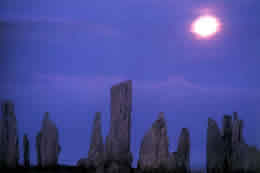Earth and Sky:Harvest Moon 秋分前后之满月(在线收听)

Harvest Moon 秋分前后之满月
Right now, as seen from the northern hemisphere, the ecliptic -- or path of the sun, moon and planets -- makes a narrow angle with the evening horizon. Learn more about the ecliptic -- and the Harvest Moon -- today on Earth and Sky..
DB: This is Earth and Sky -- Saturday, September 21. A listener asks, "Is the Harvest Moon bigger because it's closer to Earth than other full moons?"
JB: The answer is no -- the Harvest Moon isn't bigger or brighter or yellower or closer than other full moons. All full moons appear extra big just after rising, when they're still low in the sky. This is an illusion, which astronomers call the "moon illusion."
DB: Meanwhile, the Harvest Moon is just one of many names for the full moon -- in this case, it's the full moon closest to the September equinox. The equinox is tomorrow or the next day -- depending on your time zone. So tonight's full moon is the Harvest Moon.
JB: The moon usually rises about 50 minutes later each day -- but at this time of year, in the northern hemisphere, the full moon rises around the time of sunset for several evenings in a row. In the southern hemisphere, the opposite is true. There's an extra long time between moonrises there. In both cases, the reason is the angle of the ecliptic -- or path of the sun, moon and planets.
DB: From the northern hemisphere now, the moon looks entirely or nearly full for several evenings in a row -- as though September is a month with several full moons -- and with several chances to see the moon illusion. Maybe that's where the idea of the extra big size of the Harvest Moon came from.
JB: Special thanks today to Research Corporation -- a foundation for the advancement of science. We're Block and Byrd for Earth and Sky.